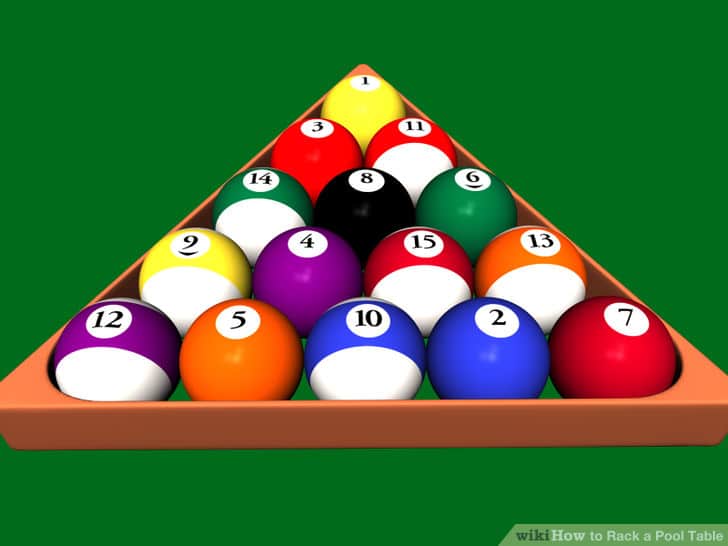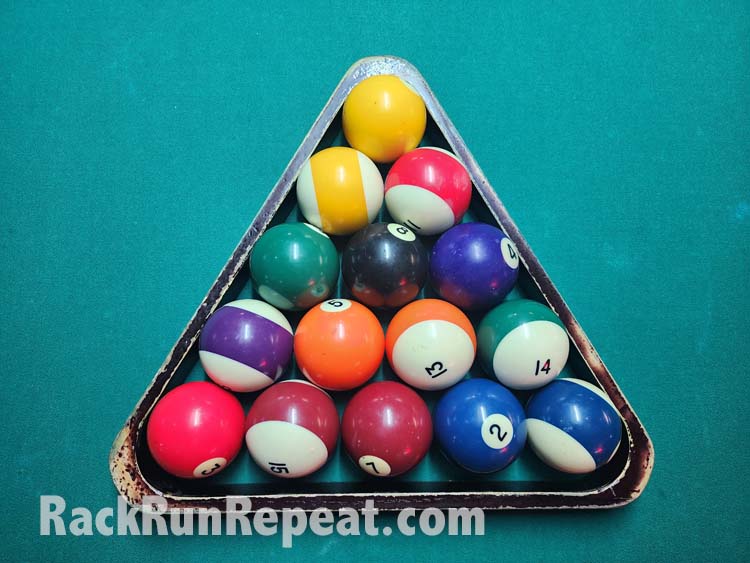How To Properly Rack Pool Balls: A Comprehensive Guide For Pool Enthusiasts
Ever wondered how to rack pool balls like a pro? Well, you're in the right place, buddy. Whether you're a casual player or a tournament-level hustler, learning the proper techniques for racking pool balls can make all the difference in your game. Pool isn't just about sinking balls; it's about precision, strategy, and yes, setting up that perfect break. Let's dive right into the world of proper racking, where every ball matters.
Imagine walking into a pool hall, confidently setting up the rack, and delivering that powerful break shot. That’s the kind of player you want to be, right? Knowing how to properly rack pool balls is more than just stacking them together; it’s about creating the ideal setup for maximum impact. This guide will walk you through everything you need to know, from the basics to advanced techniques.
We’re not just throwing random tips here. This comprehensive guide is packed with expert advice, step-by-step instructions, and even some insider tricks you might not find elsewhere. If you’re serious about improving your game, this is the article you’ve been waiting for. So grab a cue stick, take a deep breath, and let’s get started.
Read also:Who Is Levitt Actor Discover The Journey Of A Remarkable Talent
Here’s a quick look at what we’ll cover:
- The Importance of Racking
- Understanding the Basics
- Choosing the Right Rack
- Setting Up the Rack
- Proper Racking Techniques
- Racking Variations for Different Games
- Common Mistakes to Avoid
- Troubleshooting Your Rack
- Advanced Tips for Perfect Racking
- Final Thoughts
The Importance of Racking
Before we dive into the nitty-gritty, let’s talk about why racking matters so much. Picture this: you’re playing an intense game of 8-ball, and your opponent breaks with a thunderous shot. But wait—why did the cue ball just sit there, barely moving the rack? Chances are, the rack wasn’t set up properly. A well-racked triangle can mean the difference between a solid break and a dud.
Racking isn’t just about stacking balls; it’s about creating a solid foundation for your game. When done correctly, a proper rack ensures that the balls are tightly packed, allowing for maximum energy transfer during the break. This means better chances of sinking balls and controlling the cue ball’s movement.
Understanding the Basics
What is a Rack Anyway?
A rack is simply a triangular frame used to organize the balls at the beginning of a pool game. It’s usually made of plastic or metal and helps position the balls in a compact, uniform manner. But here’s the kicker: not all racks are created equal. The material, size, and even the shape can affect how well the balls stay in place during the break.
Key Components of a Proper Rack
Let’s break it down:
- Tightness: The balls should be snug against each other, leaving no gaps.
- Alignment: The apex ball (the one at the front) should be perfectly centered over the foot spot on the table.
- Uniformity: All balls should be evenly distributed within the triangle.
Getting these basics right will set you up for success every time you play.
Read also:Discover The Excitement Connecticut Wnba Team And Its Journey To Success
Choosing the Right Rack
Not all racks are suitable for every game or table. Here’s what you should consider when selecting the right rack:
Material: Plastic racks are lightweight and affordable but may wear out quickly. Metal racks, on the other hand, are durable and provide a tighter fit for the balls. If you’re serious about your game, investing in a high-quality metal rack is worth it.
Size: Standard racks are designed for 15 balls, but some games, like 9-ball, require smaller racks. Make sure you have the right size for the game you’re playing.
Shape: While most racks are triangular, there are variations for different games. For example, diamond-shaped racks are used in straight pool.
Setting Up the Rack
Step-by-Step Guide to Racking
Ready to roll up your sleeves and get to work? Here’s how to set up a perfect rack:
- Place the Rack: Position the rack on the table so that the apex ball aligns with the foot spot.
- Load the Balls: Start by placing the balls inside the rack, beginning with the apex ball. For 8-ball, the 8-ball should be in the center of the triangle.
- Press Down: Gently press down on the rack to ensure the balls are snug against each other. Avoid pressing too hard, as this can damage the rack or table.
- Remove the Rack: Carefully lift the rack straight up, ensuring the balls remain in place.
And there you have it—a perfectly set-up rack ready for action!
Proper Racking Techniques
Ensuring Tightness
One of the most common issues players face is loose racks. To avoid this, make sure the balls are tightly packed before removing the rack. You can do this by gently pressing down on the rack with your fingers or using a small object like a coin to ensure maximum pressure.
Aligning the Apex Ball
The apex ball is crucial because it’s the first point of contact during the break. Misaligning it can lead to poor energy transfer and a weak break. Always double-check that the apex ball is centered over the foot spot before proceeding.
Uniform Distribution
Each ball should have equal contact with its neighbors. This ensures that the energy from the cue ball is evenly distributed across the rack during the break. A well-distributed rack increases the likelihood of sinking multiple balls on the first shot.
Racking Variations for Different Games
8-Ball
In 8-ball, the 8-ball must be placed in the center of the triangle. The remaining balls can be arranged randomly, but some players prefer alternating solids and stripes for better aesthetics.
9-Ball
For 9-ball, the 1-ball is always at the apex, and the 9-ball is in the center. The rest of the balls can be arranged in any order, but they must still form a tight triangle.
Straight Pool
Straight pool uses a diamond-shaped rack, with the 1-ball at the apex and the 15-ball in the center. This variation requires a different setup, so make sure you have the right rack for the job.
Common Mistakes to Avoid
Even seasoned players make mistakes when racking. Here are a few to watch out for:
- Loose Balls: A loose rack can cause the balls to scatter unevenly during the break. Always ensure the balls are tightly packed.
- Misaligned Apex: If the apex ball isn’t centered, the break shot will lose its impact. Take a moment to double-check its position.
- Incorrect Ball Placement: For games like 8-ball and 9-ball, specific ball placements are required. Failing to follow these rules can result in penalties or disqualifications.
Troubleshooting Your Rack
What if your rack still doesn’t feel right? Here are a few troubleshooting tips:
Worn-Out Rack: If your rack is old or damaged, it might not hold the balls properly. Consider upgrading to a new one for better results.
Table Conditions: A dirty or uneven table surface can affect the rack’s stability. Make sure the table is clean and level before setting up the rack.
Human Error: Let’s face it—we all mess up sometimes. If your rack isn’t working, take a step back, breathe, and try again. Practice makes perfect!
Advanced Tips for Perfect Racking
Ready to take your racking skills to the next level? Here are some advanced tips to help you master the art of racking:
Use a Racking Mat: A racking mat helps keep the balls in place while you set up the rack. It’s especially useful on slippery or uneven tables.
Practice Different Techniques: Experiment with different ways of pressing down on the rack to find what works best for you. Some players prefer using their fingers, while others use tools like coins or small weights.
Watch the Pros: Study how professional players set up their racks. You might pick up a few tricks or insights that you hadn’t considered before.
Final Thoughts
Learning how to properly rack pool balls is more than just a skill—it’s an art form. By mastering the basics, understanding the variations, and avoiding common mistakes, you’ll be well on your way to becoming a racking expert. Remember, practice makes perfect, so don’t be afraid to experiment and refine your technique.
Now it’s your turn! Share your thoughts in the comments below. Do you have any racking tips or tricks you’d like to share? And don’t forget to check out our other articles for more pool-related insights. Happy racking, and may your breaks always be powerful!

/arranging-cue-balls-940411532-5af491cd8023b90036d07b04.jpg)
